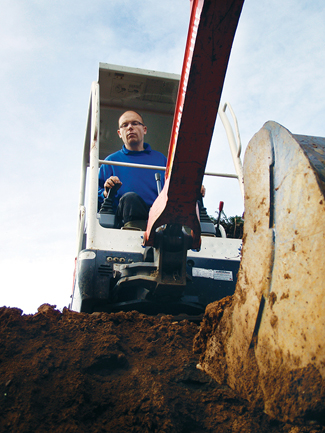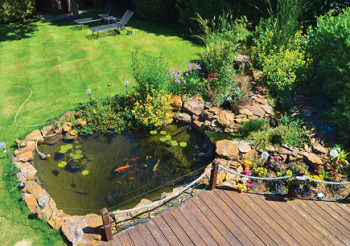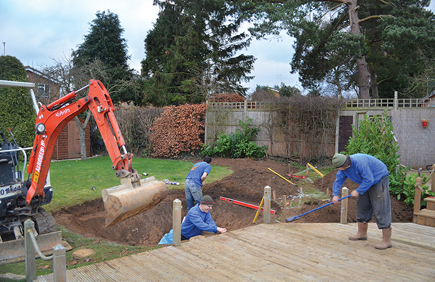The exciting pond project you see in the pictures below was built in Northamptonshire, U.K. The owners had recently moved from another property, where they had a small pond. But with a much bigger garden surrounding the new home they decided to build a more substantial pond to house their fish.

They had a good idea of the size of pond they wanted, with the husband being mainly interested in the fish whilst the wife was a keen gardener and wanted to have a planted water garden.
Both owners liked the idea of having some form of moving water, so we incorporated a planted stream with a few small falls into the design to create a wetland filtration system or a vegetable filter, as we call them in the U.K. We don’t grow vegetables, but we use this nomenclature as we are growing vegetation within the filtration system.
The Specifics
After the consultation we agreed on the construction of a new pond. Brown, hand-selected Oxfordshire ironstone was used throughout. This was chosen for its excellent longevity and “Jurassic” appearance, giving a similar finish to the local sandstone but proving much harder-wearing.
The pond was constructed in the traditional European way and is 4 meters long (14 feet) by 3 meters wide (10 feet) by 1.2 meters deep (4 feet). It was designed with both koi-keeping and water gardening in mind. There are two shelves for a couple of water lilies and a far marginal shelf away from the larger koi of course, not forgetting the water plants within the stream itself.
Typically, in the U.K. we have small gardens and often access is an issue. For this job access was a major problem; we had to remove a fence panel, as the only other access was through the house. We did not want to have to hand-dig such a large pond and “container-ize” all the spoil for removal via the house.
We used a small, 1.5-ton mini-excavator to create the rough shape of the pool and excavated down to the required depth. Then, we undertook the finishing with hand tools by forming the planting shelves before lining the pond with aquatic underlay. Finally, we covered this with the 1-millimeter (0.04-inch) PondGuard Firestone rubber liner.
Cover Your Liner!
We then created a concrete bond-beam around the perimeter of the pond and set the ironstone in this. We had bare liner underneath the bond-beam, because the customers were not too worried about looking at rocks and gravel; they were quite happy with looking at the liner.
I have quite a strong view on leaving the liner uncovered now, and it is something that we caution clients against doing as the bare liner is unprotected. Especially on deeper ponds with sloping, steep sides, there is an increased risk of damaging an uncovered liner (as you can’t get in or out easily without slipping over). Part of our work involves repairing leaking ponds, so I know just how susceptible to damage pond liners can be. Damage from dogs and rodents is common, as it is from the odd clumsy gardener. We also have an unusual problem (which may be very localized), and that is damage caused by caddis fly larvae that live on the rubber surface and have a habit of chewing the liner surface.Pumps, Streams and Falls
We have a pump-fed filtration system with the pump situated in the bottom of the pond and pushing the water up to the filters. Because the filtration system was very hard to disguise we planted a laurel hedge in front of it. These large filtration systems are full of lots of kit, giving great water clarity, but they are quite difficult to blend in with the garden setting. Because this type of filter is primarily mechanical we also installed a wetland-style filter to give a much larger area for biological filtration to take place.
[box]Busily finishing off the majority of the ground work (left) before the construction of the block walls. The photo on the right was taken with a remote-controlled DSLR on a 6-meter-high (20 feet) swimming pool handle. GoPro cameras are much easier nowadays, as you can see what you are taking and the wobble on the pole is much less.[/box]
The stream was approximately 3.6 meters long (12 feet) with a top pool containing water plants to act as a vegetable filter, which measured 1.8 meters long (6 feet) by 60 centimeters wide (2 feet) by 45 centimeters deep (18 inches). The stream had three small falls which were constructed on top of 9-inch-high and -wide block walls. The stream was planted to give a more visually appealing design, in line with the owners’ requirements.
As you can see from the pictures, concrete blocks were laid out and the waterfall was built within these. This was because the customer wanted the waterfall to be constructed from smaller stones. Again, this is something that we try to steer customers away from now, as the use of larger stones gives a more natural finished appearance. Using larger stones also reduces the requirement for the underlying solid foundation compared to using smaller stones, which need to be set on a firm base.

This particular waterfall is very difficult to modify because the stones have been permanently set in concrete. Today, we tend to use waterfall foam, which allows the design to be altered much more easily as the foam can simply be pried off the stones and then re-laid. The foam, although not structural, creates a waterproof seal around the stones that is much less cumbersome and easier to work with than the more traditional concrete construction.
Waterfall foam has revolutionized how we build ponds since it became available and has now replaced concrete mortar almost entirely as we seek to incorporate improved construction methods in our ponds.
The construction time was a total of six days for three people.
The Gear
All pond equipment was supplied by Oase. The main pond pump supplies 12,000 liters (3,170 gallons) of water per hour to a 55-watt UVC filter and then onto the large Biotech 36 filtration system. The filtration system was specifically designed with a degree of overkill to reduce the amount of maintenance. The Biotech 36 is designed to look after 36 cubic metres (1271 cubic feet) of water, but this figure needs to be halved when koi are present, and then halved again when the pond is in full sunlight. So in effect, on this pond we worked to one-quarter of the total stated maximum water volume. We also installed a wetland filtration waterfall. The water exits the Biotech filtration system and enters the wetland filter before being returned to the pond.
These customers do now regret that they did not have rocks and gravel over the whole liner and do not like looking at the pond plumbing. Unfortunately, because of the construction technique used, adding the rock would be a case of almost ripping it all out and starting again.
Challenges
The challenges that we faced on this particular project were:
Access—As with many sites in the U.K., this required some lateral thinking to solve!
A visible liner—Something we always advise against, owing to the risk of damage and our friend the caddis fly.
Difficulty in disguising the box filter—We had to install hedging in front of this to provide a screen.
The Evolution of Construction
Pond construction is now changing in the U.K. Increasingly, I see customers having more varied requirements in their ponds. Of course, for many fish are still a key element, requiring minimum sizes and depths, but very often well-planted ponds and decorative features are becoming more popular.

I find a lot of customers are not aware of how modern construction techniques have changed the range of designs that they can have. Concrete is a very expensive and difficult material to work with, as well as being difficult to change. Of course, if you are planning a large and especially a deep koi pool say, 1.8 meters (6 feet) then the structural integrity will likely require this form of construction. But for most people a pond like this is probably over-engineered.
More often we are being asked to create ponds that are multi-use, often to keep all members of the family happy! No longer is it all about the fish. Trying to mix both big fish and plants in the same pond can be a recipe for disaster if the two are allowed to mix. But careful use of rocks can keep the two apart successfully.
Most of the larger garden ponds that we build have a more multi-use design, which can still comfortably hold larger fish, but without requiring extreme depth. This opens up more varied construction techniques, allowing us to give the customers what they really want … not necessarily what they initially ask for.
New construction techniques have come on in leaps and bounds, especially “across the pond,” and I have been impressed by some of the products that I have seen on recent trips to America. Not least surface skimmers designed specifically for ponds (not “borrowed” from swimming pool designs with very small inlets and collection baskets), and the use of waterfall filtration.
Up until recent times these products have been unavailable in the U.K., primarily thanks to the high shipping costs … but this is slowly changing. Using new materials and techniques benefits not only the customer, who I believe gets a better finished product, but also reduces construction time considerably.
Choose Priorities to Build the Best Pond
Up until now, every pond in the U.K. has been built differently and required a number of different construction techniques to be employed. This does not need to be the case though. Most people want a good-looking pond that meets their objectives, be it keeping fish, providing a unique feature in the garden, or allowing them to indulge a passion for water gardening. By helping the customer decide on their priorities I find that we are able to give them what they really want in the best design possible.

Typically, pond construction methods are constantly changing. New technology is being adopted all the time, and the rate that information is being disseminated around the world has increased many-fold, thanks to social media and the Internet.
A lot of pond builders in the U.K. still build traditional-style ponds, such as the one I have talked about here, but increasingly this is changing. In August I will be taking a group of pond constructors back across the pond with me to introduce them to the different ideas. Increasing links between pond builders in different countries will help to develop the industry back in the U.K. And, notwithstanding the cost of importing bulky equipment from several thousand miles away, many of these ideas, I am sure, will begin to be adopted here.




